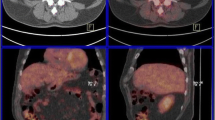Abstract
The positron emission tomography/computed tomography (PET/CT) has been a new tool utilized in the diagnosis and staging of various cancers. However, common worldwide utilization of the PET/CT includes some economic, legal, and ethic controversies. Although PET/CT scanning can detect colorectal premalignant lesions in an early treatable stage, most governments’ health care system does not pay for it as a screening test because of its economic burden. Thus, people are forced to make vital decisions about their health because of health policies of their governments. Here, we present an unusual case and discuss the utilization of PET/CT for detection of incidental neoplasms.



Similar content being viewed by others
References
Wang XL, Yin JL, Li H, Li XD, Quan JT (2007) PET/CT imaging of delayed radiation encephalopathy following radiotherapy for nasopharyngeal carcinoma. Chin Med J 120:474–478
Alavi A, Gupta N, Alberini JL, Hickeson M, Adam LE, Bhargava P et al (2002) Positron emission tomography imaging in nonmalignant thoracic disorders. Semin Nucl Med 32:293–321
Wollmer P, Rhodes CG (1988) Positron emission tomography in pulmonary edema. J Thorac Imaging 3:44–50
Lorraine T (2007) Positron emission tomography (PET) and mammography (PEM) for breast cancer: importance to surgeons. Ann Surg Oncol 14:3–13
Chuck A (2005) Positron emission tomography (PET) mammography: a new diagnostic tool. Int J Technol Assess Health Care 21(4):442–51
Yasuda S, Shohtsu A, Tsutsumi Y (1998) Colonic adenoma detected by positron emission tomography (PET): a case report. Tokai J Exp Clin Med 23(3):153–155
Selby JV, Friedman GD, Quesenberry CP Jr, Weiss NS (1992) A case-control study of screening sigmoidoscopy and mortality form colorectal cancer. N Engl J Med 326:653–657
Author information
Authors and Affiliations
Corresponding author
Rights and permissions
About this article
Cite this article
Caliskan, C., Karaca, C., Ozsoy, M. et al. Unexpected Benefit of the Positron Emission Tomography/Computed Tomography Using 18F-Fluorodeoxyglucose: Report of a Case. Indian J Surg 78, 348–350 (2016). https://doi.org/10.1007/s12262-016-1477-y
Received:
Accepted:
Published:
Issue Date:
DOI: https://doi.org/10.1007/s12262-016-1477-y




